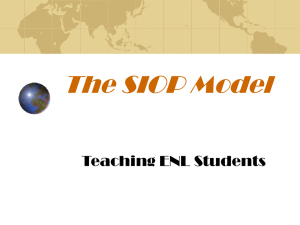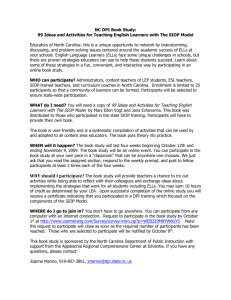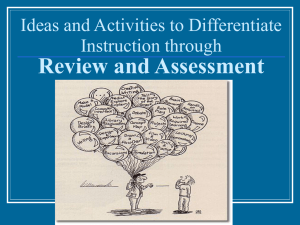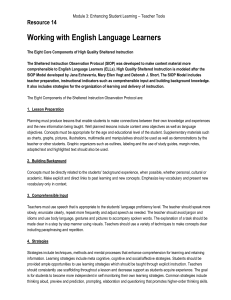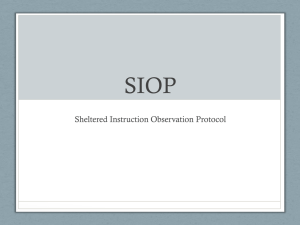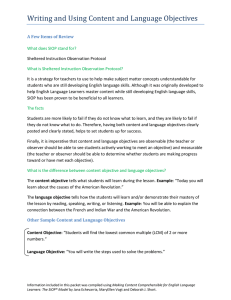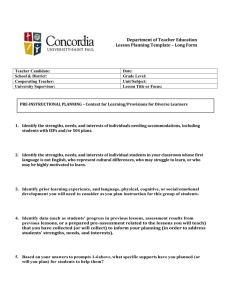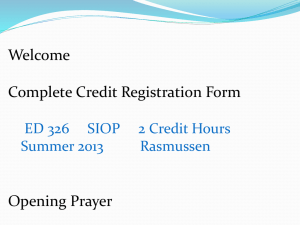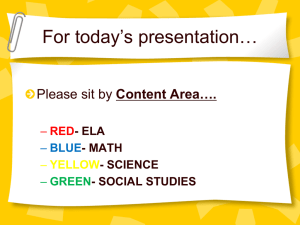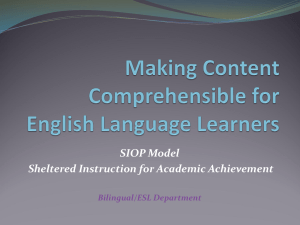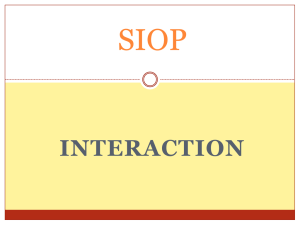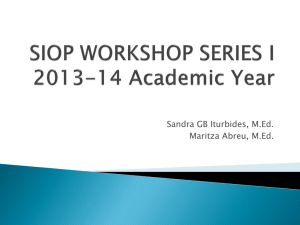Sheltered Instruction Observation Protocol Model (SIOP
advertisement
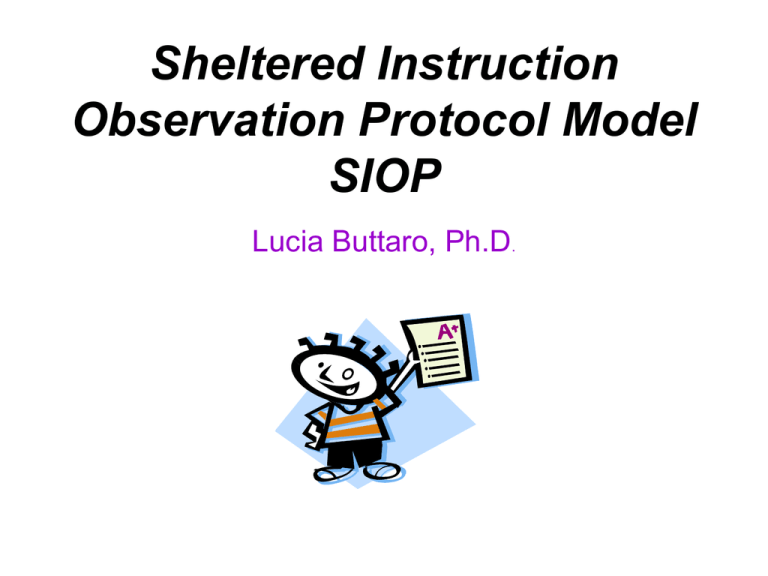
Sheltered Instruction Observation Protocol Model SIOP Lucia Buttaro, Ph.D. Why should all teachers learn SIOP? Statistics: “Projections suggest that “language minority students” ( those who speak a language other than English at home and who have varying levels of proficiency in English) will comprise over 40% of elementary and secondary students by 2030” (Thomas and Collier, 2001). “Of the 41 percent of teachers who taught English language learners, less than 13 percent had received eight or more hours of training in the last three years in how to teach ELL students (National Center for Education Statistics, 2002a). If not now, then when? If not us, then who? What is SIOP? • It is purposefully teaching of the language necessary for English Language Learners to understand the academic content of the material. OBJECTIVES • Overview of the SIOP Model • Unpacking 4 Components: • Preparation • Building Background • Review/Assessment • Strategies Components of the SIOP Model (Echevarria, Vogt, & Short, 2008) • • • • • • • • Preparation Building Background Comprehensible Input Strategies Interaction Practice/Application Lesson Delivery Review/Assessment Lesson Preparation Component Lesson Preparation involves: • • • • • • Content objectives clearly defined, displayed and reviewed Language objectives clearly defined, displayed and reviewed Content concepts appropriate for age and educational background level of students Supplementary materials used to a high degree, making the lesson clear and meaningful (i.e. computer programs, graphs, models, visuals) Adaptation of (i.e. text assignment) to all levels of student proficiency Meaningful activities that integrate lesson concepts (i.e. interviews, letter writing, simulations, models) with language practice opportunities for reading, writing, listening and/or speaking. Objectives Content Objectives Language Objectives Objectives that identify what students should know and should be based on Common Core Standards. Objectives that support students’ language development and skills in listening, speaking, reading, writing. A content objective explicitly states what information the students will be required to master at the end of the lesson A language objective states how students will be able to express what they have learned in their native and/or second language Example: Students will learn about the causes of the American Revolution and the conflicts between the American patriots and the British. Example: Students will be able to: • provide 4 causes of the American Revolution either orally or in writing • write a persuasive essay on the subject • discuss colonist’s feelings about British rule Making Content Comprehensible • Lesson Preparation: you must ensure rigor and relevance • http://vidego.multicastmedia.com/player.ph p?p=wzsf4417 Ways to Adapt Content “I pledge allegiance to the frog of the United States of America and to the wee public for witches hands one Asian, under God, in the vestibule with little tea and just rice for all.” ― Bette Bao Lord, In the Year of the Boar and Jackie Robinson Students will look to adapt anything new to them to what they already know so try to build on any background they have! Other ways to adapt content for ELL’s: 1. Write shorter sentences 2. Simplify vocabulary and grammar 3. Add easier language for clarification 4. Repeat words 5. Use structure clues for context ( first, then, next) 6. VISUAL AIDS! GRAPHIC ORGANIZERS! REALIA!! ADAPTATION OF CONTENT • Make texts accessible to all students without “watering down” • Differentiate (same content objective BUT different input/output/process) • Scaffold • Adjust content to various learning styles and intelligences Examples of adaptation of content • Thinking Maps/graphic organizers: schematic visuals that help students grasp the wholeness and parts of a concept. • Outlines: - help students take note in an organized manner • Highlighted text: highlight key concepts, important vocabulary and summary statement can help reduce stress Supplementary Materials • They make the lesson clear and meaningful • Make content concepts “concrete”, tangible, visible, understandable • Support learning styles • Support multiple intelligences • Make it REAL! Examples of supplementary materials: • Hands on manipulatives and realia • Pictures, photos, visuals • Multimedia – film clips, songs, chants, posters, computer games. These help solidify concepts into students’ deep memory. • Demonstrations: model step-by-step completion of tasks or model language to use with presentations • Related materials: leveled books of both fiction and non-fiction that supplement the theme Other Components of Lesson Preparation • Meaningful Activities: integrate lesson concepts (e.g. interviews, letter writing, simulations, models) with language practice opportunities for reading, writing, listening, and/or speaking. • Supplementary materials: used to a high degree, making the lesson clear and meaningful (e.g. computer programs, graphs, models, and visuals). • Content concepts: appropriate for age and educational background level of students. Assessment • Assessment is gathering and synthesizing of information concerning student learning • Evaluation is making judgments about students’ learning • http://vidego.multicastmedia.com/player.ph p?p=vfmu984j Authentic Assessment • * application to real life- real life contexts • Multi dimensional – Portfolios – Students’ writings – Taped pieces – Interviews – Videotapes – performances – discussions Strategies • Provide ample opportunity for students to use learning strategies • Scaffolding techniques should be used consistently to assist and support student understanding (e.g., think-alouds). • Use a variety of questions or tasks that promote higher order thinking skills (e.g., literal, analytical, and interpretative questions) More on Strategies • Questioning • Wait Time: (effective teachers wait 20 seconds or more) • Note: ELLs may need longer than that. • Clarify key concepts in first language: allow students to confer with each other, teacher, or paraprofessional in their native language about subject matter to support understanding. • Review key vocabulary: multiple exposures to new vocabulary Comprehensible Input • Explanation of academic tasks: – Present instructions in a step-by-step manner and/or with demonstrations. – Peer modeling – Scaffolding: – Verbal scaffolding – paraphrasing, thinkalouds – Increase independence: – Explicit teaching /modeling/practicing/applying Metacognitive Strategies: “thinking about your thinking” • • • • • • Predicting/inferring Self-questioning Monitoring/clarifying Evaluating Summarizing Visualizing SIOP Summary • Review Key Features of SIOP • Provide Time for “Works/Quirks/Questions” • Evaluation Handout which will include: S – Something I learned… I – I will use… O – One question I have… P – Please clarify this… English Language Learners • “If the child is not learning the way you are teaching, then you must teach in the way the child learns.” Rita Dunn Bibliography Echevarria, J., Vogt, M. & Short, D. (2007). Making Content Comprehensible for English language learners: The SIOP Model (3rd ed.). Needham Heights, MA. Allyn and Bacon. Flynn, K. &Hill, J. (2005). English Language Learners: A Growing Population. Mid-Continent Research for Education and Learning Policy brief. National Center for Education Statistics. (2002a). Schools and staffing survey:1999-2000. Retrieved November 19, 2011 from http://nces.ed.gov/pubs 2002/2002313.pdf). Thomas, W.P., & Collier, V. (1997). School effectiveness for language minority students. Washington, D.C.: National Center for Bilingual Education. Additional Websites: ahonigsfeld@molloy.edu http://www.siopinstitute.net/
